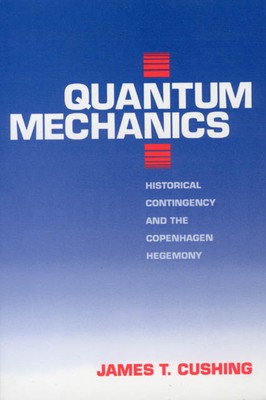
- We will send in 10–14 business days.
- Author: James T Cushing
- Publisher: University of Chicago Press
- ISBN-10: 0226132048
- ISBN-13: 9780226132044
- Format: 15.3 x 23.1 x 2 cm, softcover
- Language: English
- SAVE -10% with code: EXTRA
Reviews
Description
Why does one theory succeed while another, possibly clearer interpretation, fails? By exploring two observationally equivalent yet conceptually incompatible views of quantum mechanics, James T. Cushing shows how historical contingency can be crucial to determining a theory's construction and its position among competing views.
Since the late 1920s, the theory formulated by Niels Bohr and his colleagues at Copenhagen has been the dominant interpretation of quantum mechanics. Yet an alternative interpretation, rooted in the work of Louis de Broglie in the early 1920s and reformulated and extended by David Bohm in the 1950s, equally well explains the observational data. Through a detailed historical and sociological study of the physicists who developed different theories of quantum mechanics, the debates within and between opposing camps, and the receptions given to each theory, Cushing shows that despite the preeminence of the Copenhagen view, the Bohm interpretation cannot be ignored. Cushing contends that the Copenhagen interpretation became widely accepted not because it is a better explanation of subatomic phenomena than is Bohm's, but because it happened to appear first. Focusing on the philosophical, social, and cultural forces that shaped one of the most important developments in modern physics, this provocative book examines the role that timing can play in the establishment of theory and explanation.EXTRA 10 % discount with code: EXTRA
The promotion ends in 11d.22:34:27
The discount code is valid when purchasing from 10 €. Discounts do not stack.
- Author: James T Cushing
- Publisher: University of Chicago Press
- ISBN-10: 0226132048
- ISBN-13: 9780226132044
- Format: 15.3 x 23.1 x 2 cm, softcover
- Language: English English
Why does one theory succeed while another, possibly clearer interpretation, fails? By exploring two observationally equivalent yet conceptually incompatible views of quantum mechanics, James T. Cushing shows how historical contingency can be crucial to determining a theory's construction and its position among competing views.
Since the late 1920s, the theory formulated by Niels Bohr and his colleagues at Copenhagen has been the dominant interpretation of quantum mechanics. Yet an alternative interpretation, rooted in the work of Louis de Broglie in the early 1920s and reformulated and extended by David Bohm in the 1950s, equally well explains the observational data. Through a detailed historical and sociological study of the physicists who developed different theories of quantum mechanics, the debates within and between opposing camps, and the receptions given to each theory, Cushing shows that despite the preeminence of the Copenhagen view, the Bohm interpretation cannot be ignored. Cushing contends that the Copenhagen interpretation became widely accepted not because it is a better explanation of subatomic phenomena than is Bohm's, but because it happened to appear first. Focusing on the philosophical, social, and cultural forces that shaped one of the most important developments in modern physics, this provocative book examines the role that timing can play in the establishment of theory and explanation.

Reviews